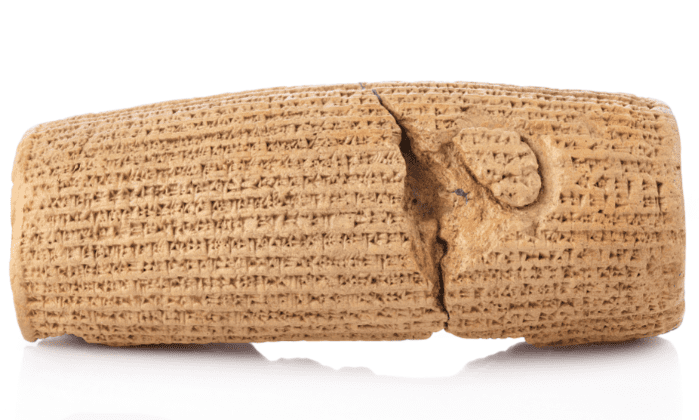Cyrus Cylinder
Babylonia, 538 BC
Original at the British Museum Collection, London
In this declaration Cyrus the Great King of Persia allows the
restoration of various temples and religious cults, and the
return of previously deported gods and people. According to
the Book of Ezra, after having experienced a revelation, Cyrus
allowed the Jews to return to their country and rebuild the
Temple of Jerusalem
Must Know
The Cyrus Cylinder was written by Cyrus, the king of the Persian Empire in 538 BC, who conquered the Babylonian empire and established Persia as the dominant power in the region until Alexander the Great. The cylinder was a declaration that gave religious autonomy to all the peoples living under Babylon who were conquered by the Persians. However, it did not allow any political autonomy. The declaration was written upon a cylinder in Akkadian cuneiform, and it is considered the oldest human rights document in the world. At the archeological site where it was discovered, there was no specific reference to the Jews.
As the Persian Empire ruled a vast area (present day Middle East), the unique political approach of Cyrus was to consider the conquered peoples as an integral part of the empire and, thus, to treat these with tolerance and respect. The declaration had several motives. From a political point of view, Cyrus believed that giving respect and freedom of religion to the conquered peoples could win the people’s loyalty and respect, and it could, as a result, strengthen the political control of the empire. From a religious point of view, he was a polytheist (i.e., he believed in many gods) and thus he found a way to respect all the different gods. In addition, from a personal point of view, Cyrus wanted to be perceived as an enlightened and tolerant ruler and as a king who liberated the people from the tyranny of Babylon. The cylinder allowed the Jews to return to their land after being exiled from there following the destruction of the First Temple in 586 BC and also allowed them to build the Second Temple in 516 BC. The declaration allowed them to maintain their identity and religion in their land.
More Info
The cylinder was discovered in 1879 by an Assyrian archeologist Hormuzd Rassam at the ruins of the Babylonian temple Esagila (a word whose meaning is “temple whose top is lofty”), located about 50 kilometers south from present day Baghdad. The discovery had been transferred to the United Kingdom and ever since exhibited in the British Museum. The Cyrus Cylinder is mentioned as something unique to the Jews in the Book of Ezra in the Old Testament, due to the fact that Cyrus allowed the Jews to return to their land and to raise the Second Temple.
2600 years ago, Cyrus established the largest empire ever seen, and had been the first one to introduce human rights for all people. he was the grandfather of Ahasuerus, the one from the Book of Esther. he conquered Babylon, became the ruler of the Babylonian Empire. As a response to the efforts of the last Babylonian king, Nabonidus, who made attempts to increase the number of gods and especially the power of the god Sin, Cyrus began his religious restoration work. The priests of the god Marduk, the chief god in Babylonian culture, disliked the fact that their status had been repressed. Therefore, they encouraged and even helped Cyrus conquer the city Babylon without battle, to remove Nabonidus from power, and to restore the status of Marduk, and once again their own status as priests. Later, Cyrus declared religious autonomy all over his new kingdom.
The discovery of the Cyrus Cylinder became a source of conflict between the British Museum, whose collection the original cylinder is a part of, and the organization National heritage of Iran. The British Museum was supposed to loan the exhibit to Iran, however, due to the political tension with Israel, they did not show any interest in doing so.

